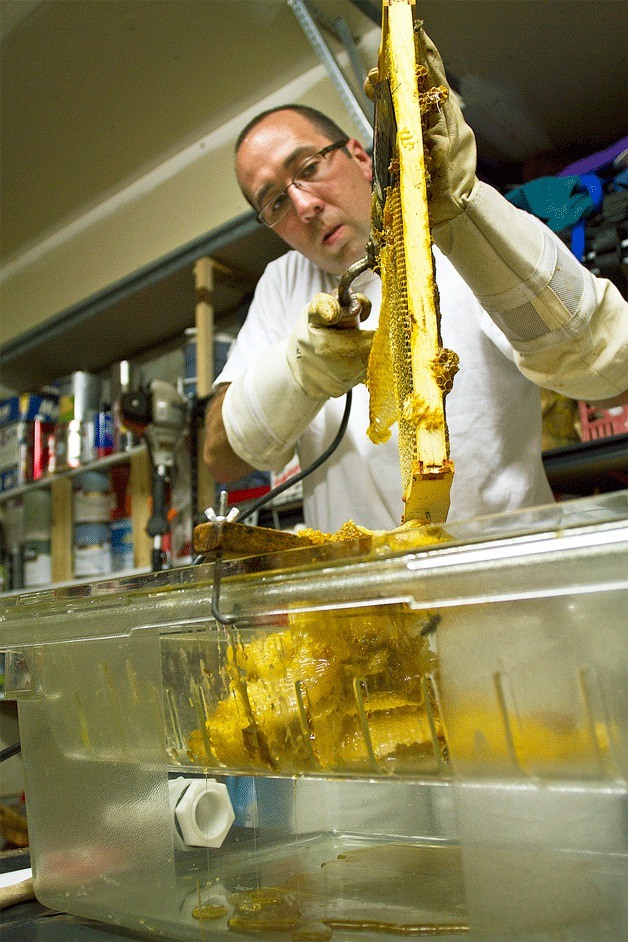“You get stung as much as you want to,” said Ben McCafferty in response to the inevitable question asked of all beekeepers.
“Or, at least as much as you are willing to.”
McCafferty, a Bainbridge Island firefighter with seven years of beekeeping experience, is one of a rapidly growing number of hobbyists on the island.
“I’m just the instigator,” he said. “I get other people interested, but there are a lot of guys with more experience than me.”
It’s not a common hobby, comparatively, though beekeeping does seem to be a growing subculture in America, and especially in the Pacific Northwest.
“There are more beekeepers on the island than before,” McCafferty said. “Maybe 15 or 20 in our Bainbridge group.”
Between the time demands of beekeeping, the space required to keep hives safely, the daily threat of being stung and the constant specter of the much-written about Colony Collapse Disorder, which seems to be decimating the world bee population, one might wonder what kind of person would actually want to be a beekeeper? What kind of busybody chooses to spend their time around these dangerous insects?
The really crazy part of it is that these guys do it for fun.
“We’re just having fun with it,” McCafferty said. “We’re not out to save the world or anything.”
Fun may be the reason they continue keeping bees, but the starting point for every beekeeper is plain old-fashioned curiosity.
“I think they’re fascinating,” McCafferty said of the bees.
Allen Turnbull, another Bainbridge firefighter and novice beekeeper, agrees.
“It surprised me how docile they actually are,” he said.
“I think most people have a misconception about bees are afraid of them. They don’t realize how important bees are and what they mean for our food supply,” McCafferty said.
Most professional beekeepers make a living by physically moving hives from one crop area to another, ensuring proper pollination for whatever is in season at the time. The importance of the mobile hive system cannot be overstated.
From an article by Rowan Jacobsen on EatingWell.com: “About 35 percent of the food we eat — $15 billion worth of produce in the United States and $215 billion worldwide — would not exist without pollinators. Once we had thousands of native insects that provided all our pollination needs, but habitat destruction and the ever-increasing size of industrial farms have put most of our crops out of reach of wild bugs. The only way to bring pollination to these plants is to truck it in, and the honeybee is the only pollinator that will endure such a domesticated lifestyle.”
It would be a mistake to dismiss the essential role of bees in a healthy and sustainable ecosystem, and for the beekeepers of Bainbridge Island September is the time of year by which a year’s worth of hard work is deemed successful. This is harvest time.
“We usually harvest in August,” McCafferty said. “When it’s still really warm. We’re lucky to have this little warm snap this year.”
The extra time did not turn out to mean more honey this season, and Bainbridge beekeepers are reporting a smaller haul this year than in the past.
“Each frame typically holds about three pounds, or one quart of honey,” explained McCafferty of the most common hive design. “It’s been an off-year nationwide.”
Even with only two years of experience, Allen Turnbull sees the difference as well.
“Last year was a very good year,” he said. “I got about 85 pounds of honey out of just two hives.”
McCafferty isn’t worried, and said that a drop in production is perfectly natural and is caused by many factors. In his years of experience, he’s seen production fluctuate before.
McCafferty and many of the other Bainbridge beekeepers harvest their honey with a radial honey extractor, a modern electrical-powered version of what was once a hand-operated crank system.
Frames of honeycomb are literally cut open with a heated blade, to remove the natural caps the bees create to store the honey, and are then placed in the extractor at an upward angle. When the machine spins the frames, the centrifugal force pushes the honey out of the comb and it collects at the bottom of the machine where it can be drained and rationed into storage containers. No further treatment or processing is necessary.
“Honey is one of the only products in the world that is naturally bacteria-free,” McCafferty explained. “I don’t use any chemicals or treatments; we keep it all raw and organic.”
Not all bee species are as domesticated as those kept by McCafferty and Turnbull, and people are cautioned to not wander too close to unknown hives, especially in the wild.
For those interested in bees and considering keeping a hive of their own, McCafferty advises that books are research alone just aren’t enough to really prepare somebody for this hobby.
“Find a good mentor,” he said. “You can take a class, which is great, and you can read a lot, which is also important. But there’s no substitute for having a mentor who has seen and done things in your particular area and can tell you what certain things mean when you see them in the hive.”
With a little experience, he said, even the time investment is not as big as most people think.
“I would say the time commitment is like having a garden,” McCafferty said. “It’s not overwhelming.”
For more information about bees and beeping, contact the West Sound Beekeepers Association at info@WestSoundBees.org or visit www.westsoundbees.org. You can also attend a beginners class at 7 p.m. on the third Tuesday of every month at Stedman’s Bee Supplies in Silverdale. Call 360-692-9453 for more information.


